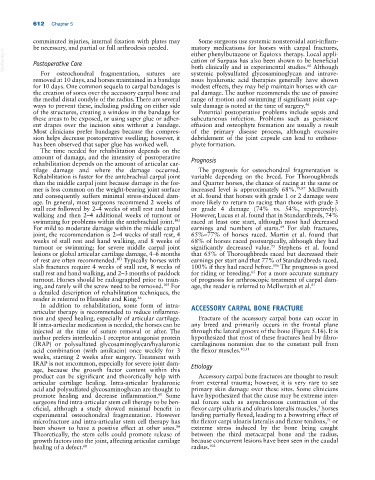Page 646 - Adams and Stashak's Lameness in Horses, 7th Edition
P. 646
612 Chapter 5
comminuted injuries, internal fixation with plates may Some surgeons use systemic nonsteroidal anti‐inflam-
be necessary, and partial or full arthrodesis needed. matory medications for horses with carpal fractures,
VetBooks.ir Postoperative Care cation of Surpass has also been shown to be beneficial
either phenylbutazone or Equioxx therapy. Local appli-
both clinically and in experimental studies. Although
60
For osteochondral fragmentation, sutures are systemic polysulfated glycosaminoglycan and intrave-
removed at 10 days, and horses maintained in a bandage nous hyaluronic acid therapies generally have shown
for 10 days. One common sequela to carpal bandages is modest effects, they may help maintain horses with car-
the creation of sores over the accessory carpal bone and pal damage. The author recommends the use of passive
the medial distal condyle of the radius. There are several range of motion and swimming if significant joint cap-
ways to prevent these, including padding on either side sule damage is noted at the time of surgery. 46
of the structures, creating a window in the bandage for Potential postoperative problems include sepsis and
these areas to be exposed, or using super glue or adher- subcutaneous infection. Problems such as persistent
ent drapes over the incision sites without a bandage. effusion and osteophyte formation are usually a result
Most clinicians prefer bandages because the compres- of the primary disease process, although excessive
sion helps decrease postoperative swelling; however, it debridement of the joint capsule can lead to entheso-
has been observed that super glue has worked well. phyte formation.
The time needed for rehabilitation depends on the
amount of damage, and the intensity of postoperative
rehabilitation depends on the amount of articular car- Prognosis
tilage damage and where the damage occurred. The prognosis for osteochondral fragmentation is
Rehabilitation is faster for the antebrachial carpal joint variable depending on the breed. For Thoroughbreds
than the middle carpal joint because damage in the for- and Quarter horses, the chance of racing at the same or
mer is less common on the weight‐bearing joint surface increased level is approximately 68%. 79,87 McIlwraith
and consequently suffers minimal stress‐induced dam- et al. found that horses with grade 1 or 2 damage were
age. In general, most surgeons recommend 2 weeks of more likely to return to racing than those with grade 3
stall rest followed by 2–4 weeks of stall rest and hand or grade 4 damage (74% vs. 54%, respectively).
walking and then 2–4 additional weeks of turnout or However, Lucus et al. found that in Standardbreds, 74%
swimming for problems within the antebrachial joint. raced at least one start, although most had decreased
103
For mild to moderate damage within the middle carpal earnings and numbers of starts. For slab fractures,
69
joint, the recommendation is 2–4 weeks of stall rest, 4 65%–77% of horses raced. Martin et al. found that
weeks of stall rest and hand walking, and 8 weeks of 68% of horses raced postsurgically, although they had
turnout or swimming; for severe middle carpal joint significantly decreased value. Stephens et al. found
75
lesions or global articular cartilage damage, 4–6 months that 65% of Thoroughbreds raced but decreased their
of rest are often recommended. Typically horses with earnings per start and that 77% of Standardbreds raced,
103
slab fractures require 4 weeks of stall rest, 8 weeks of 100% if they had raced before. The prognosis is good
116
stall rest and hand walking, and 2–3 months of paddock for riding or breeding. For a more accurate summary
65
turnout. Horses should be radiographed prior to train- of prognosis for arthroscopic treatment of carpal dam-
ing, and rarely will the screw need to be removed. For age, the reader is referred to McIlwraith et al. 81
103
a detailed description of rehabilitation techniques, the
reader is referred to Haussler and King. 46
In addition to rehabilitation, some form of intra‐ ACCESSORY CARPAL BONE FRACTURE
articular therapy is recommended to reduce inflamma-
tion and speed healing, especially of articular cartilage. Fracture of the accessory carpal bone can occur in
If intra‐articular medication is needed, the horses can be any breed and primarily occurs in the frontal plane
injected at the time of suture removal or after. The through the lateral groove of the bone (Figure 5.16). It is
author prefers interleukin‐1 receptor antagonist protein hypothesized that most of these fractures heal by fibro-
(IRAP) or polysulfated glycosaminoglycan/hyaluronic cartilaginous nonunion due to the constant pull from
acid combination (with amikacin) once weekly for 3 the flexor muscles. 10,31
weeks, starting 2 weeks after surgery. Treatment with
IRAP is not uncommon, especially for severe joint dam- Etiology
age, because the growth factor content within this
product can be significant and theoretically help with Accessory carpal bone fractures are thought to result
articular cartilage healing. Intra‐articular hyaluronic from external trauma; however, it is very rare to see
acid and polysulfated glycosaminoglycan are thought to primary skin damage over these sites. Some clinicians
promote healing and decrease inflammation. Some have hypothesized that the cause may be extreme inter-
60
surgeons find intra‐articular stem cell therapy to be ben- nal forces such as asynchronous contraction of the
eficial, although a study showed minimal benefit in flexor carpi ulnaris and ulnaris lateralis muscles, horses
5
experimental osteochondral fragmentation. However landing partially flexed, leading to a bowstring effect of
71
microfracture and intra‐articular stem cell therapy has the flexor carpi ulnaris lateralis and flexor tendons, or
been shown to have a positive effect at other sites. extreme stress induced by the bone being caught
80
Theoretically, the stem cells could promote release of between the third metacarpal bone and the radius,
growth factors into the joint, affecting articular cartilage because concurrent lesions have been seen in the caudal
healing of a defect. 60 radius. 102

